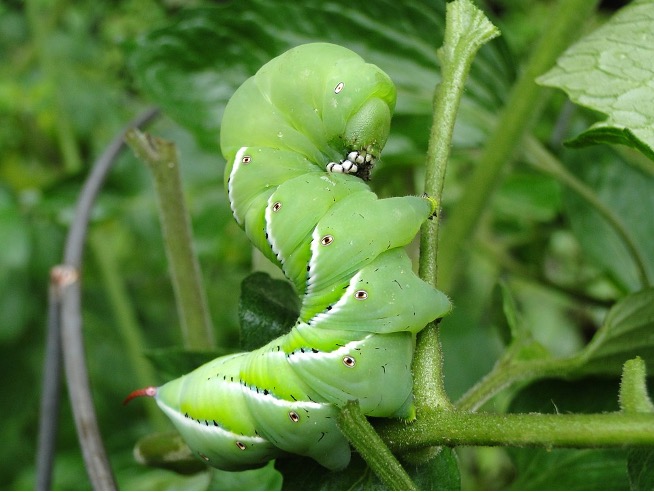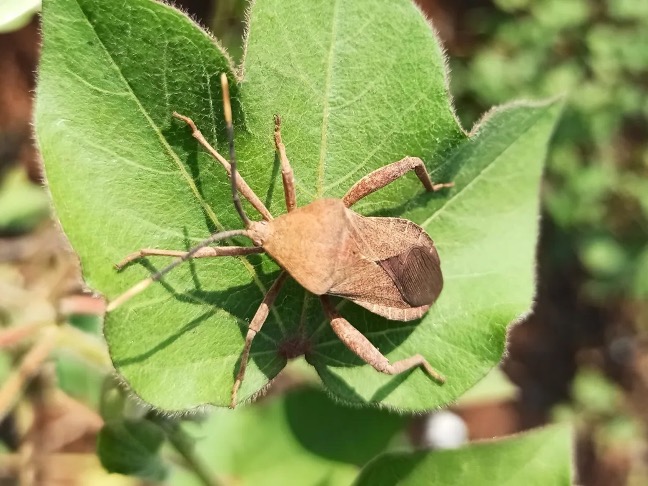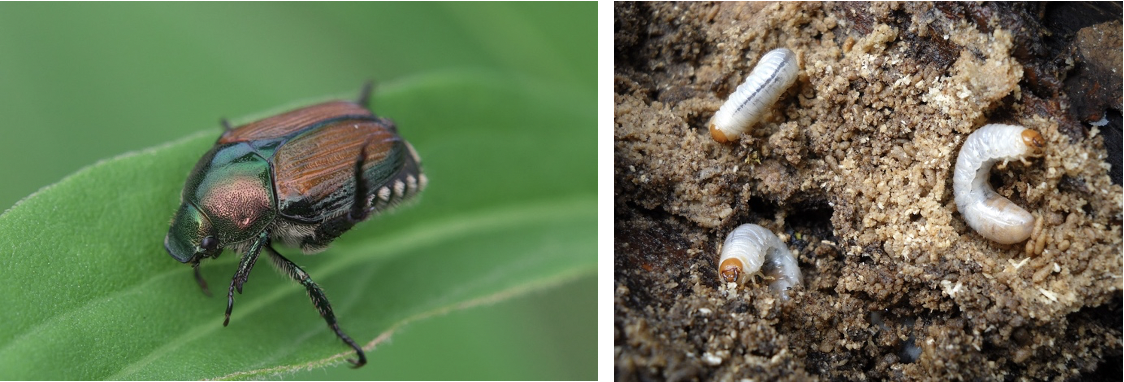-Sara Vandersip-
 As the summer heat persists, so do summer pests. Prevention and treatment for some of those pesky summer bugs in your garden is very important for keeping your plants alive and healthy. Here is our beginner’s guide to getting rid of four common pests: aphids, caterpillars, squash beetles, and June beetles.
As the summer heat persists, so do summer pests. Prevention and treatment for some of those pesky summer bugs in your garden is very important for keeping your plants alive and healthy. Here is our beginner’s guide to getting rid of four common pests: aphids, caterpillars, squash beetles, and June beetles.
If you see little green bugs on your leaves, especially their undersides, you’re most likely dealing with aphids. They are quite tiny, with adults measuring under ¼ inch. Aphids remove nutrients by feeding on the plant’s juice, and they can do significant damage in large numbers. Some of the most common signs of aphid damage are:
- yellowing, misshaped, or curling leaves
- distorted flowers or fruit
- black leaves or stems from fungal growth called sooty mold
- sticky sap, called “honeydew,” covering the plant, produced from the waste of aphids
Treating an aphid infestation is relatively simple. Our favorite organic product for aphid control is PureCrop 1. You spray a diluted solution onto the colony, and it acts by breaking down an enzyme in the insects’ gut so they can’t feed on your plants anymore. You can also use insecticidal soap, horticultural oil, and neem oil. Neem oil is an organic insecticide effective at killing aphids and it can be applied as a preventative measure as well. If you prefer dusting treatments rather than sprays, we recommend applying diatomaceous earth, a non-toxic, organic material that will kill aphids by puncturing their exoskeletons.
In terms of biological controls, ladybugs and beneficial nematodes are a couple of other solutions to control aphids. Our native ladybugs eat up to 100 aphids a day and can keep your plants aphid-free while bringing good luck! Nematodes are tiny, parasitic worms that will infect root aphids without causing harm to earthworms, plants, or animals.
 Caterpillars are a summer pest that can easily damage a crop without being noticed until it’s too late. They are the larval stage of a butterfly or moth. Although some caterpillars are mostly harmless, certain types, such as hornworms or bagworms, can destroy your plants very quickly and are serious pests. Because they camouflage well, they can be hard to find. Here are signs of caterpillar damage in your garden:
Caterpillars are a summer pest that can easily damage a crop without being noticed until it’s too late. They are the larval stage of a butterfly or moth. Although some caterpillars are mostly harmless, certain types, such as hornworms or bagworms, can destroy your plants very quickly and are serious pests. Because they camouflage well, they can be hard to find. Here are signs of caterpillar damage in your garden:
- Defoliation of the plant
- Holes, rolled or webbed leaves
- Eggs or excrement on the plant
Harmful caterpillars in your garden can be treated effectively with Monterey B.t., whose active ingredient is bacteria that naturally occur in the soil and are destructive to caterpillars. We also recommend Monterey Garden Insect Spray with Spinosad, another naturally occurring bacteria, or diatomaceous earth. All of these are organic solutions to kill caterpillars that are damaging your plant.
 Squash bugs, as their name would suggest, are most often found on squash plants like zucchini, pumpkins, and winter squash, but they can also affect other plants such as cucumbers or watermelon. Be careful not to mistake these guys for stink bugs because there are similarities; squash bugs are more narrow and will cause much more damage. They are over ½ inch long, move quickly, and like to hide out on the undersides of leaves. Some signs that you have squash bugs in your garden are:
Squash bugs, as their name would suggest, are most often found on squash plants like zucchini, pumpkins, and winter squash, but they can also affect other plants such as cucumbers or watermelon. Be careful not to mistake these guys for stink bugs because there are similarities; squash bugs are more narrow and will cause much more damage. They are over ½ inch long, move quickly, and like to hide out on the undersides of leaves. Some signs that you have squash bugs in your garden are:
- Yellow or brown spots
- Wilting leaves that eventually turn brittle, crispy and black
- Ragged holes in the leaves
- Smaller plants and young fruit die
Make sure you spot these critters early on, because adult squash bugs are very difficult to get rid of. With squash bugs, an ounce of prevention is worth a pound of cure. The best way to deal with them is to make sure they never get to your plants in the first place. You can cover your crops with a physical barrier like Agribon Row Cover so the bugs can’t plant their larvae into the stems of your plants.
For larger infestations, you’ll want to scrape off the eggs and pick off the bugs from the plant, or create a squash beetle trap by laying cardboard/newspaper around the plant at night. The bugs will collect beneath it, and in the morning you can drop them into a bucket of soapy water. Neem oil is also effective if you have a large infestation, since squash bugs tend to be resistant to pesticides.

June bugs and Japanese beetles can do some serious damage to your lawn and garden. The beetles themselves can be detrimental to plant foliage (particularly Japanese beetles), but even more of a concern are their larvae. These are also called “white grubs,” and have a white, C-shaped appearance. They feed on plants’ roots and can wreak havoc on the plants. You can spot damage from these pests as:
- Holes in the foliage of the plant
- Dead patches of grass or lawn
- Skeletonized leaf or plant, for large infestations
To treat and prevent June bugs and Japanese beetles, you can use a variety of physical and biological treatments. The best long-term solution is Milky Spore, a biological pest control that kills the larvae that live in your soil. One application can last more than ten years, but can take up to two years to reach its full efficacy. Agribon is again a good option for preventing the beetles from accessing your plants. You can also use Monterey B.t., diatomaceous earth, Japanese beetle traps, and as a last resort pyrethrin. If you decide to use the traps, place them in the area of your yard that is farthest from the plants you want to protect. These bags are very effective, but they will attract beetles from off of your property.
Summer pest control and management can feel overwhelming, so we hope this quick guide puts some of your worry at ease. Remember, to protect our pollinators by spraying in the evening once the bees have gone to bed, avoiding flowers when you spray, and only using the heavy-duty insecticides like pyrethrin if all else fails. If you are having trouble identifying a pest infestation or want more information on treatment, contact us or come into the shop for advice!

Leave a Reply